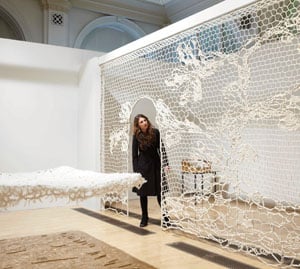A tale of two halves
Annabelle Campbell and Andy Horn share their experiences of the partnership between the Crafts Council and Birmingham Museums and Art Gallery

Working in partnership is a very strong model of working and an important one for both the Crafts Council and Birmingham Museums and Art Gallery (BMAG). We collaborated the ‘Lost in Lace: New approaches by UK and international artists’ exhibition, when BMAG was selected as the first partner in the Crafts Council’s Fifty:Fifty scheme; an initiative in which the Crafts Council develops and delivers a contemporary exhibition with a partner organisation.
Partnership working enables knowledge sharing, internal development and review of existing practices. It brings together different experiences, skills and personalities (institutional as well as individual) and allows us to achieve more than is possible individually. It does, of course, come with challenges – potentially operating within someone else’s constraints and dealing with organisational habits (not all good) whilst trying to stay true to the individual identities and objectives of both organisations.
With this in mind we felt that a critical element to the success of our working relationship would be to establish at the outset a set of agreed aims and objectives. This agreed ‘manifesto’ was invaluable at times when pressure and schedule pushed for resolution on areas of potential disagreement. However such guiding principles couldn’t solve every problem – differing points of view still had to be dealt with. It is at this point that trust and communication were imperative. As a project team – employees of the Crafts Council and BMAG, plus independent curator Professor Lesley Millar – we felt comfortable contesting and challenging each other in order to reach the optimum solution. Communication channels had to be clear and immediate as the project demanded daily contact for months, mainly via email and telephone but also through regular meetings (alternatively in London and Birmingham). Outside of the project team there were also multiple partners, including exhibition designers, graphic designers, PR agencies and local authorities. Such a potentially confusing infrastructure demanded a practical model for communication in terms of points of contact, decision-making and signing off. We achieved this from the outset and it proved invaluable. Having this in place, underpinned by the pre-agreed working principles, meant that we were able to work effectively and efficiently.
Excellent communication also meant that we knew where the strengths of the team lay – which team members would do what best. The pooling of skills, knowledge and capabilities was a fundamental part of the project and the rich dynamic of these skills gave a momentum that may have not been achieved from one organisation alone.
Trust was also an essential element as both organisations had to take a leap of faith and believe in each others’ specialist knowledge. In the case of Lost in Lace, whilst the aim was ambitious and international, BMAG brought a deep understanding of the local audience that the Crafts Council could not have done. Likewise as a national agency, the Crafts Council brought a different perspective that dovetailed neatly with that of BMAG’s. Knowing and trusting in these strengths was ultimately reflected in the proven impact of the project.
One of the more obvious advantages to partnership working is sharing costs in a challenging economic climate, but this did not mean it was all plain sailing. The development period of an exhibition can take two to three years; the sector landscape can significantly change in this time. During the development of Lost in Lace, BMAG had a major restructure with a loss of about 30 posts and the Crafts Council experienced change following Arts Council England’s funding structure amendments. This meant, amongst other things, installing a complex exhibition with a much reduced technical team. All of which called for some more traits beneficial to partnership working – flexibility, a can-do attitude and sense of humour.
The question around risk and failure is one that can not be avoided when reviewing a partnership project. If a project attracts substantial funding, with multiple stakeholders, it has to succeed and be successful on as many levels as possible. As organisations it is necessary to take risks in order to push ourselves and our sectors forward. Consequently a margin of error is acceptable, but with the case of Lost in Lace, as both partners are publically-funded bodies, the project demanded a clear public benefit. We know from our evaluation of Lost in Lace that we succeeded in engaging the public and bringing in a new audience. The evaluation showed that 34% of visitors had not visited BMAG before – a higher than usual level of new audiences. In turn this meant that it produced a new audience for contemporary crafts and in particular contemporary textile practice.
All parties embarking on a partnership project should be confident in advance that their teams are pragmatic, resourceful and willing to compromise. For some of the Lost in Lace project team it was the first time that they had worked truly collaboratively with an external organisation. We feel confident in speaking on behalf of all the team’s members to say that whilst it was challenging it was also hugely rewarding. We learned a great deal as individuals and as organisations, and the partnership has left a positive legacy for new ways of working and thinking.
Join the Discussion
You must be logged in to post a comment.